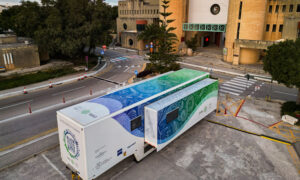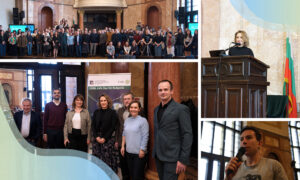
EMBL’s southern hemisphere connection
Ian Smith, Chair of EMBL Australia’s Council, chats about the synergies between the organisations, opportunities for collaboration, and ideas for exciting new programmes arising out of a recent visit to EMBL Heidelberg

EMBL is an intergovernmental organisation with 28 member states. The laboratory also has a strong and deeply valued southern hemisphere connection; Australia has been an EMBL associate member state since 2008.
EMBL Australia is a life science network that maximises Australia’s use of EMBL membership, supporting ambitious research projects and facilitating access to infrastructures and training. The flagship programme of EMBL Australia is the Partner Laboratory Network, a network of research groups led by outstanding early-career researchers at nodes around the country.
Australia’s associate membership of EMBL is funded through the Australian government’s National Collaborative Research Infrastructure Strategy (NCRIS). Representatives from Australia’s NCRIS Health Group – a collaboration of capabilities, including EMBL Australia, working together to improve the health of Australians – recently visited EMBL’s headquarters in Heidelberg. The delegation toured EMBL facilities and met with scientists and senior leadership, including Director General Edith Heard.
We took the opportunity to chat with EMBL Australia Council Chair Ian Smith about the benefits, opportunities, and potential for future collaborations between European and Australian researchers.
What do you consider the benefits of Australia’s associate membership?
We have been absolutely delighted with the quality of the research that is taking place across our Partner Laboratory Network, which is a direct consequence of the quality of the fellows that we have managed to recruit and the research partnership community that has been built up in Australia, all through our EMBL membership. Through these partner programmes, we’re training the future scientific leaders of Australia, supported by contacts with the other EMBL sites and associated networks.
An unexpected benefit of our affiliate membership is the kind of meetings that we’re having on this visit – using EMBL as a vehicle to explore other areas of opportunities and learnings within Europe, particularly in the research infrastructure space. For example, we are learning about European best practices, how best to share new techniques, and where collaborative opportunities lie. Across the globe, we are all facing similar challenges in managing research infrastructure, so it’s beneficial having the opportunity to share our experiences and, importantly, discuss how we can best address these challenges.
What were the most outstanding discussion topics during your visit?
An example is the TREC Expedition in which EMBL is mapping flora and fauna and changes around the coastlines of Europe. We have similar programmes in Australia, which has diverse and, like Europe, changing climate conditions. We are therefore very interested in the opportunities to work more closely and to share and combine data. Data management is crucial but challenging, and EMBL-EBI is an organisation that knows how to handle data and can help solve some of these data problems.
Of course, we are looking at the challenges of climate change – many of the challenges in Australia are similar to the ones in Europe. By working together, we can exchange ideas and hopefully come up with new solutions.
Besides these challenges and opportunities, we also discussed the importance of properly recognising and rewarding the people who run research infrastructure and how to improve our training programs. EMBL leads the way in terms of training and we would like to take advantage of these established training programs, but at the same time, we also have much to offer in terms of training. We would like to see two-way traffic between Australia and Europe as part of the shared vision that we should be doing more together. I think now, after the pandemic, people are starting to move towards building these kinds of relationships and revisiting and sharing experiences.
Do you see future areas of collaboration and scientific exchange beyond those already mentioned?
We already have good exchange programs with students and our younger fellows visiting regularly, but the area we haven’t explored yet is more senior career people. We see, for example, opportunities for more senior researchers to do sabbaticals of between three to six months in both Europe and Australia. The specific aim would be to help facilitate the exchange of ideas, to learn and introduce new techniques, and to perhaps explore co-supervision opportunities for students.
During these discussions, we all felt that these expanded exchange programs would be beneficial for the researchers, open the door for more collaborations, and promote EMBL / EMBL Australia partnership growth. We would, however, need to think carefully about how best we should approach and implement these additional programmes.
The International Conference for Research Infrastructures (ICRI) will be held soon in Australia. What are your expectations?
I think the programme itself will be great, but what excites me most is the potential satellite meetings. For example, we are anticipating that the research infrastructure leaders from the health and biology space will hold a meeting to work through many of the issues we raised and discussed at the recent European/Australian/EMBL research infrastructure meeting in Prato, Italy. I think this is very exciting and, together with our global colleagues, not only will we start developing solutions to these problems, but such a meeting will also help build stronger ties, enable the sharing of critical insights, and start building a more globalised and collaborative community.
Your final word?
I would like to highlight the continued high level of goodwill and cooperation between EMBL and EMBL Australia, which has led to a truly impressive level of collaboration and interaction. I think the expanded and very ambitious programme that EMBL has put in place (Molecules to Ecosystems) will open the door for more people to engage, both from within the EMBL Australia partnership, as well as from within the broader Australian research community.
The spirit of cooperation and the willingness to collaborate has already led to several successful shared programmes between different institutions. This growth in cross institutional collaborations is both a real highlight, as well as a great indicator of the EMBL partnership success.


